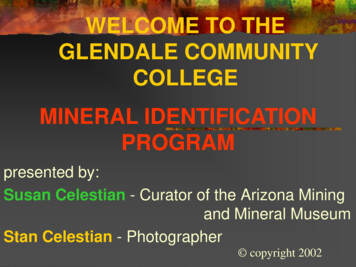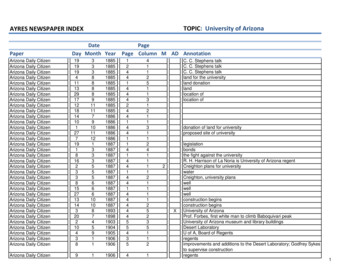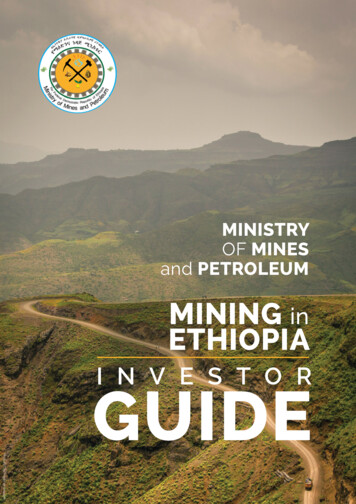
Transcription
WELCOME TO THEGLENDALE COMMUNITYCOLLEGEMINERAL IDENTIFICATIONPROGRAMpresented by:Susan Celestian - Curator of the Arizona Miningand Mineral MuseumStan Celestian - Photographer copyright 2002
Where do minerals come from? Minerals from magma Magma rises from the mantle and coolsWhen it cools, it crystallizes into minerals.If it cools quickly, it forms small crystals. (granite) If it cools slowly, it forms large crystals. (salt)
Where do minerals come from? Minerals from solutions Minerals can dissolve into a solution.When enough minerals are in the solution, theystick together and precipitate. They form a solid while still in the solution. Minerals can also crystallize when thesolution evaporates (called evaporites)
Mineral Identification Basics What is a Mineral?There is a classic four partdefinition for mineral.Minerals must be:Naturally occurringInorganicPossess a definite crystallinestructureHave a definite chemicalcompositionCubic Fluorite Crystal
Mineral Identification Basics What is a Mineral?Naturally OccurringMinerals are not synthetic - they are producedby the natural geological processes working onEarth. For example, steel, brass, bronze andaluminum are not considered minerals in thatthey are not found in nature.Technically speaking, synthetic gemstones arenot considered minerals.Tourmaline Crystal from Brazil
Mineral Identification Basics What is a Mineral?InorganicMinerals are NOT produced by organicprocesses.“NOT a Mineral List”Barite Rose - A flower like growthof Barite crystals.TeethBonessea shellskidney stonesPearlsCoralCoalAmber
Mineral Identification Basics What is a Mineral?Internal StructureMinerals are the result of atoms joiningtogether through electrical bonds to produce adefinite internal structure.It is the nature of the atoms and the strength ofthe chemical bonds that determine many of theminerals’ physical and chemical properties.Crystalline Pattern of HaliteRed SodiumHalite (salt) from Searles Lake, CAGreen Chlorine
Mineral Identification Basics What is a Mineral?Definite Chemical CompositionHalite - NaClFor every atom of Sodium there isan atom of Chlorine.Minerals can be expressed by a chemicalformula. The internal order of mineralsmeans that there is a definite relationship inthe number of atoms that makes up themineral.
Mineral Identification Basics PHYSICAL PROPERTIES HARDNESSHARDNESS is defined as theresistance a mineral has to beingscratched - its “scratchability”.Hardness tests are done byscratching one mineral againstanother. The mineral that isscratched is softer than the other.Pyrite CrystalsHardness of 6.5
Mineral Identification Basics PHYSICAL PROPERTIES HARDNESSIn this photo, a quartz crystal has beenrubbed across a glass plate. The resultis that the glass plate was scratched.The quartz is therefore harder than theglass.Quartz is harder than glass.HINT: In doing a hardness test try to pick asmooth or flat surface on the mineral to bescratched. Try to pick a point or a sharp edge onthe mineral that you think will do the scratching.Glass is usually a good place to start because it is inthe middle of the hardness table, it has a flat,smooth surface and it is easily obtained.
Mineral Identification Basics PHYSICAL PROPERTIES HARDNESSCare must be taken on some minerals that crumble easily.Remember that hardness is the resistance a mineral has to beingscratched - NOT how easily it breaks apart. The physicalproperty related to the ease in which a mineral breaks is tenacity.Also be sure to determine the hardness of a mineral on a freshsurface whenever possible. Some minerals have a tendency tooxidize or corrode. These surface deposits usually have adifferent hardness than the fresh mineral.
Mineral Identification Basics PHYSICAL PROPERTIES HARDNESSMOH’S SCALE OF MINERAL HARDNESS6. FELDSPAR1. TALC7. QUARTZ2. GYPSUM8. TOPAZ3. CALCITE4. FLUORITE9. CORUNDUM5. APATITE10. DIAMONDOTHER MATERIALS COMMONLY USED:2.5 - FINGERNAIL3 - COPPER PENNY5.5 - GLASS6-6.5 - STEEL FILE
Mineral Identification Basics PHYSICAL PROPERTIES CLEAVAGECLEAVAGE is the property of amineral that allows it to breakrepeatedly along smooth, flatsurfaces.These GALENA cleavage fragments wereproduced when the crystal was hit with ahammer. Note the consistency of the 90oangles along the edges.These are FLUORITE cleavage fragments.
Mineral Identification Basics PHYSICAL PROPERTIES CLEAVAGEWithin this crystalline pattern it iseasy to see how atoms willseparate to produce cleavage withcubic (90o) angles.
Mineral Identification Basics PHYSICAL PROPERTIES CLEAVAGEThese pictures show different cleavage angles and the quality of cleavage.Fluorite has cleavage in fourdirectionsMicaA thinhassheetperfectof Muscovitecleavage inseenONEondirection.edge.
Mineral Identification Basics PHYSICAL PROPERTIES CLEAVAGECommon salt (the mineral HALITE) has very good cleavage in 3 directions.These 3 directions of cleavage aremutually perpendicular resulting incubic cleavage.
Mineral Identification Basics PHYSICAL PROPERTIES CLEAVAGERhombohedralCleavage - 3 directionsCALCITEEven these tiny fragments have rhombohedral cleavage.
Mineral Identification Basics PHYSICAL PROPERTIES CLEAVAGEBlocky Cleavage2 directionsOrthoclase feldspar has goodNotethat the faces in the circle are atcleavage in 2 directions.Orthoclase Feldspardifferent levels. By adjusting the lighting,Theappearanceof thisspecimen isall ofblockythe parallelfaces willreflectasimultaneously.hint that it has cleavage.thatThis resultsThein aclueflashofthecleavagefacesis thelightspecimenfrom all hasthe parallel. fact thatnumerous faces will reflect light at thesame time. Each face is parallel and lightwill reflect of each face producing a flashof light.
Mineral Identification Basics PHYSICAL PROPERTIES CLEAVAGETALC has micaceous cleavage.That is to say that it cleaves likemica (1 perfect direction) but, intalc the crystals are so small thatthey cannot easily be seen.Instead the effect is that the talc“feels soapy”. The second pictureshows some of the talc that hascleaved onto the fingers.
Mineral Identification Basics PHYSICAL PROPERTIES CLEAVAGEFLUORITE cleavage octahedron
Mineral Identification Basics PHYSICAL PROPERTIES FRACTUREFRACTURE is defined as the way amineral breaks other than cleavage.This is a piece of volcanic glass calledOBSIDIAN. Even though it is NOT amineral, it is shown here because it hasexcellent conchoidal fracture.If you try this yourself, use caution.Conchoidal fracture in obsidian canproduce extremely sharp edges.
Mineral Identification Basics PHYSICAL PROPERTIES FRACTUREThis Quartz crystal has beenstruck with a hammer toshow how the external formof the crystal does not repeatwhen broken.This is a good example ofconchoidal fracture.Note the smoothcurved surfaces.
Mineral Identification Basics PHYSICAL PROPERTIES STREAKSTREAK is defined as thecolor of the mineral in powderform.Streak is normally obtained by rubbing amineral across a “streak plate”. This is apiece of unglazed porcelain. The streak platehas a hardness of around 7 and rough texturethat allows the minerals to be abraded to apowder. This powder is the streak.Hematite on Streak PlateHematite has a reddish brown streak.
Mineral Identification Basics PHYSICAL PROPERTIES STREAKSphalerite is a dark mineral,however, it has a light coloredstreak. Next to the reddish brownstreak of hematite is a light yellowstreak. This is the streak of thesphalerite.Light colored streaks are oftendifficult to see against the whitestreak plate. It is often useful to rubyour finger across the powder to seethe streak color.Sphalerite has a light yellow streak.
Mineral Identification Basics PHYSICAL PROPERTIES LUSTERLUSTER is defined as thequality of reflected light.Minerals have been grosslyseparated into eitherMETALLIC orNONMETALLIC lusters.Following are some examples:Native Silver has a Metallic Luster
Mineral Identification Basics PHYSICAL PROPERTIES LUSTER METALLICStibnitePyriteGalenaMarcasite
Mineral Identification Basics NON-METALLIC LUSTER VITREOUSOlivine - PeridotQuartzWulfeniteSpinel
Mineral Identification Basics NON METALLIC LUSTERMiscellaneous LustersAsbestos- Silky- PearlyGraphitehas a greasy orApophyllitesubmetallic lusterand easily marks paper.Sphalerite - ResinousLimonite - Dull or Earthy
Mineral Identification Basics PHYSICAL PROPERTIES LUSTERThe moral to this story isto look at a fresh surfacewhenever possible.This piece of Native Copper isseverely weathered. It does notlook metallic.This is the same piece but the leftside has been buffed with a steelbrush. Note the bright metallicluster.
Mineral Identification Basics PHYSICAL PROPERTIES COLORThe COLOR of a mineral is usuallythe first thing that a person noticeswhen observing a mineral. However, itis normally NOT the best physicalproperty to begin the mineralidentification process.Following are some examples of colorvariation within mineral speciesfollowed by minerals that have adistinctive color:Various colors of CALCITE.
Mineral Identification Basics PHYSICAL PROPERTIES COLORAmethystIonic IronClear - Without ImpuritiesHematite InclusionsVarious colors of Quartz.Chlorite inclusions
Mineral Identification Basics INDICATIVE COLORAzuriteTurquoiseRhodochrositeSulfurMalachite
Mineral Identification Basics PHYSICAL PROPERTIES MAGNETISMMAGNETISM is the ability of a mineralto be attracted by a magnet. This mostcommonly is associated with minerals rich iniron, usually magnetite.This is a piece of MAGNETITE with a magnetadhering to it. Magnetite is strongly magnetic inthat a magnet will easily be attracted to it.
Mineral Identification Basics PHYSICAL PROPERTIES MAGNETISMMore sensitivity is achieved if instead of a largesample, small pieces are used. In this way, evenweakly magnetic minerals will be attracted tothe magnet.
Mineral Identification Basics PHYSICAL PROPERTIES MAGNETISMThis is a sample of “black sand”from Lynx Creek, Arizona. Its darkcolor is due to its highconcentration of magnetite. Seewhat happens when a magnet isplace beneath the bottom rightportion of the paper.This technique is used to separate out much of the unwanted material in the searchfor gold in placer deposits.
Mineral Identification Basics PHYSICAL PROPERTIES MAGNETISMLODESTONE is a varietyof Magnetite that isnaturally a magnet.
Mineral Identification Basics PHYSICAL PROPERTIES DIAPHANEITYThe manner in which minerals transmit light iscalled DIAPHANEITY and is expressed by theseterms:TRANSPARENT: A mineral is considered to betransparent if the outline of an object viewed throughit is distinct.TRANSLUCENT: A mineral is considered to betranslucent if it transmits light but no objects can beseen through it.OPAQUE: A mineral is considered to be opaque if,even on its thinnest edges, no light is transmitted.Quartz withSpessartine Garnets
Mineral Identification Basics PHYSICAL PROPERTIES DIAPHANEITYTRANSPARENT: A mineral is consideredto be transparent if the outline of an objectviewed through it is distinct.Topaz from Topaz Mountain, Utah
Mineral Identification Basics PHYSICAL PROPERTIES DIAPHANEITYTRANSLUCENT: A mineral isconsidered to be translucent if it transmitslight but no objects can be seen through it.Sylvite from Salton Sea, CaliforniaBacklit Apophyllite Crystals
Mineral Identification Basics PHYSICAL PROPERTIES DIAPHANEITYOPAQUE: A mineral is considered to beopaque if, even on its thinnest edges, nolight is transmitted.Schorl - The black variety ofTourmaline
Mineral Identification Basics DOUBLE REFRACTIONDOUBLEREFRACTION:Is aproperty shared by many minerals( but not those in the isometriccrystal system). It is bestdisplayed in the mineralCALCITE. This image clearlyshows the double image below thecalcite
Mineral Identification Basics CHEMICAL PROPERTIESREACTION TO HYDROCHLORIC ACIDSome minerals, notably the carbonates,react to cold dilute HCl. In thisillustration a piece of CALCITE isshown to react (fizz) after HCl is applied.Calcite Reacts to HCl
Uses of Rocks and Minerals
Mineral IdentificationRESOURCESFor lots of useful images of minerals and more facts about minerals,check out this web ive/index.htm
This copyrighted Power Point CD was produced strictly for educationalpurposes. Any attempt at using the images within this program formonetary gain is illegal. The authors have given permission to use theprogram or parts of it, providedTHEcredit is given to the Arizona Mining andMineral Museum, its Curator - Susan Celestian and the photographer Stan Celestian.END
Mineral Identification Basics PHYSICAL PROPERTIES HARDNESS In this photo, a quartz crystal has been rubbed across a glass plate. The result is that the glass plate was scratched. The quartz is therefore harder than the glass. Quartz is harder than glass. HINT: In doing a hardness test try to pick a smooth or flat surface on the mineral to be











